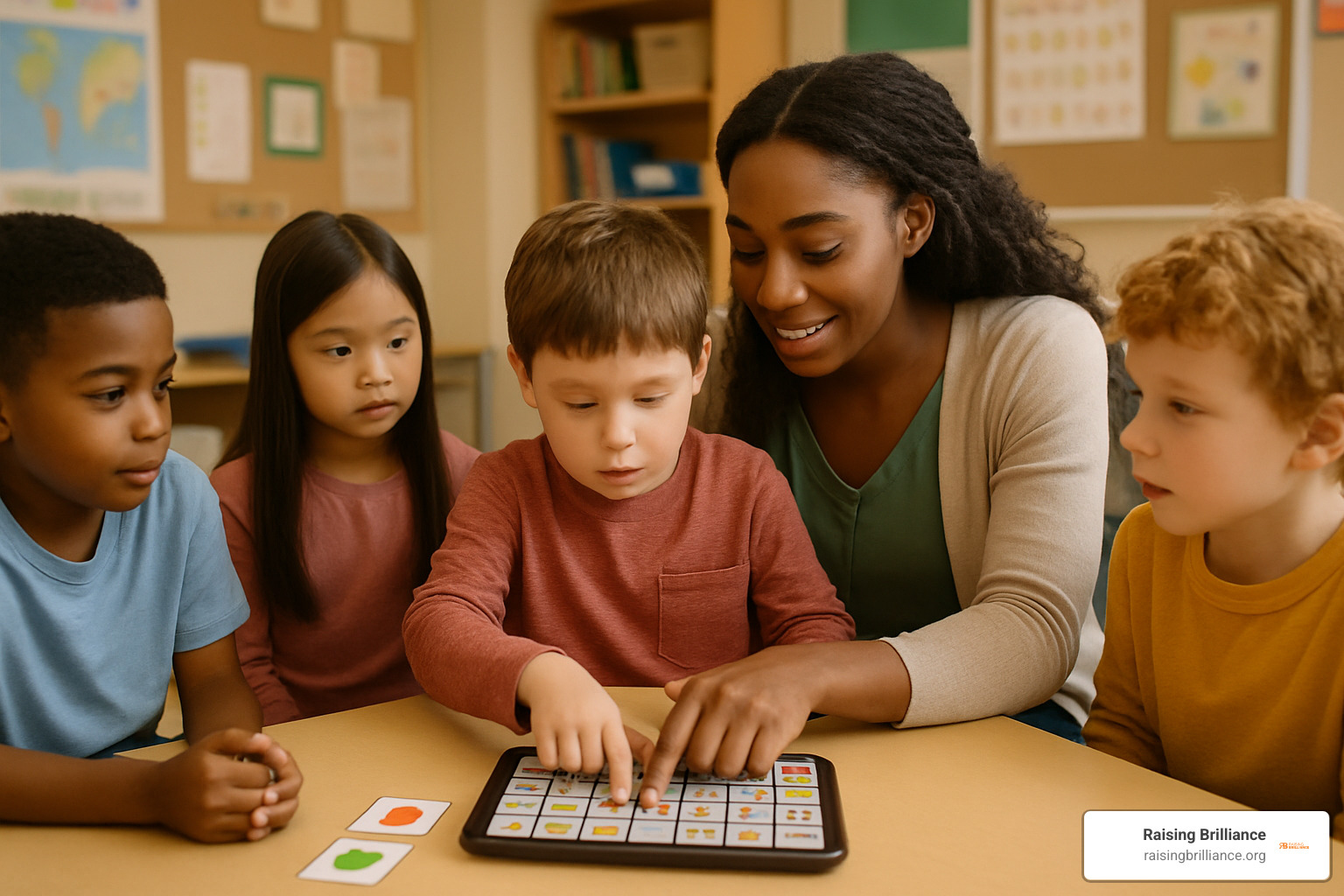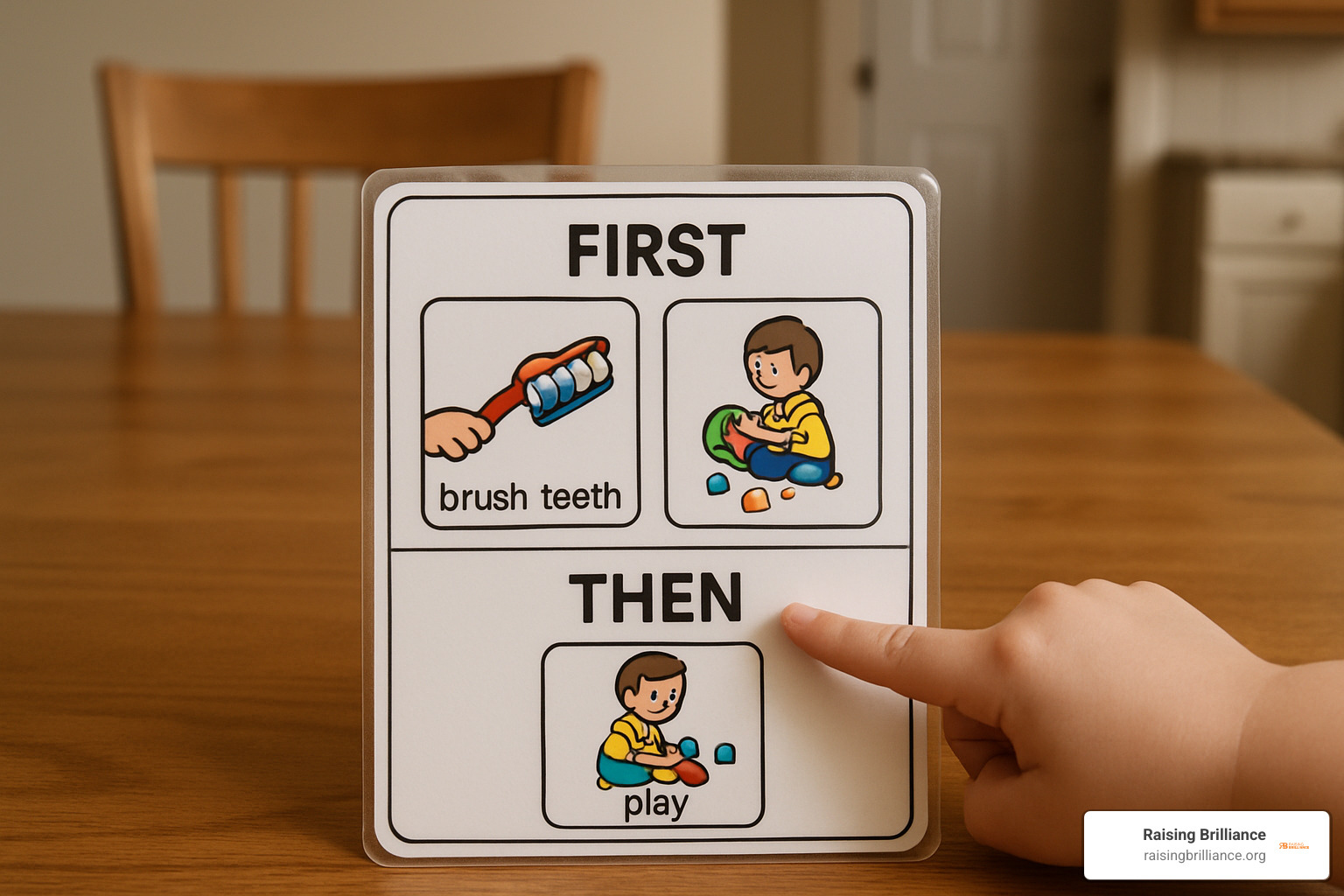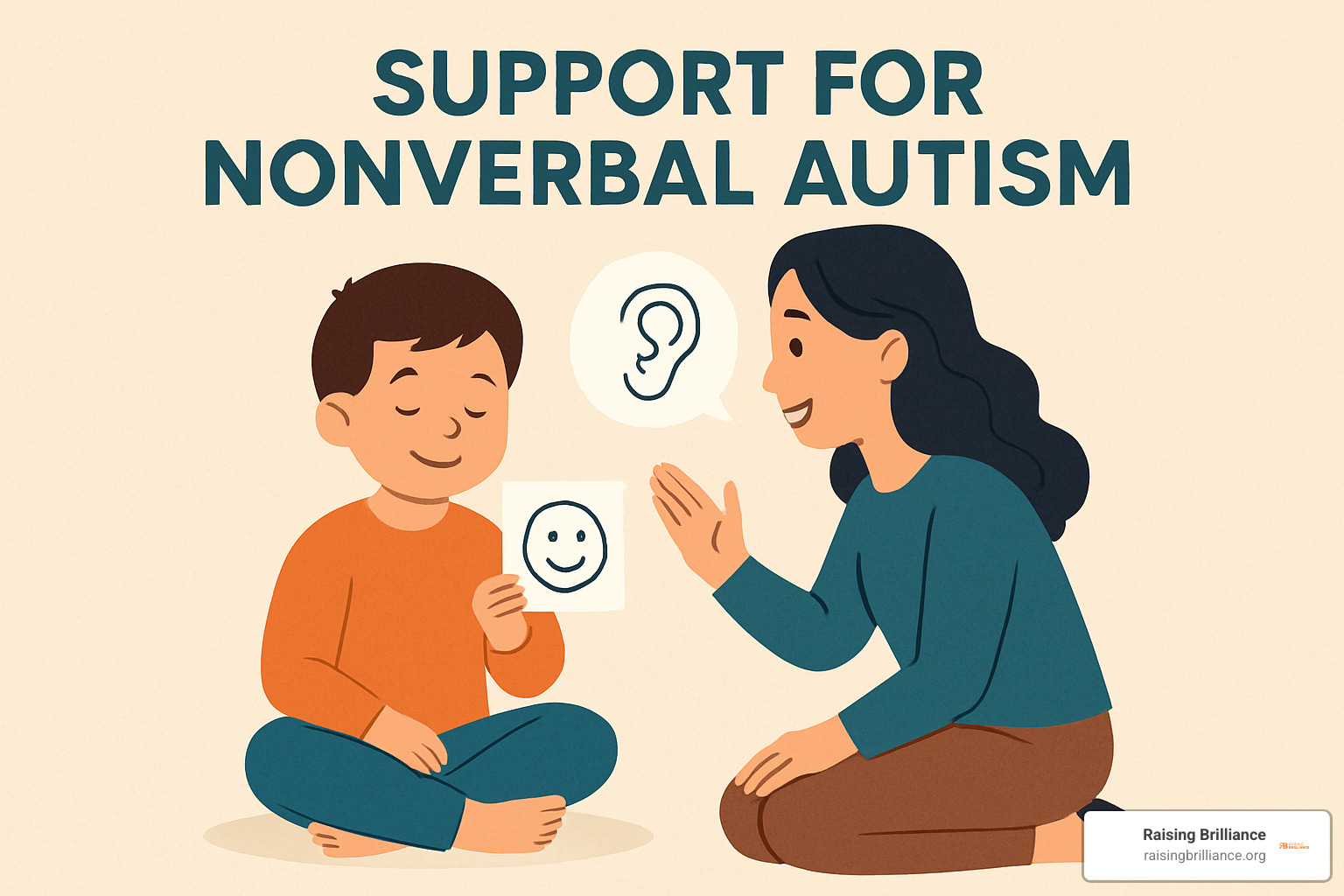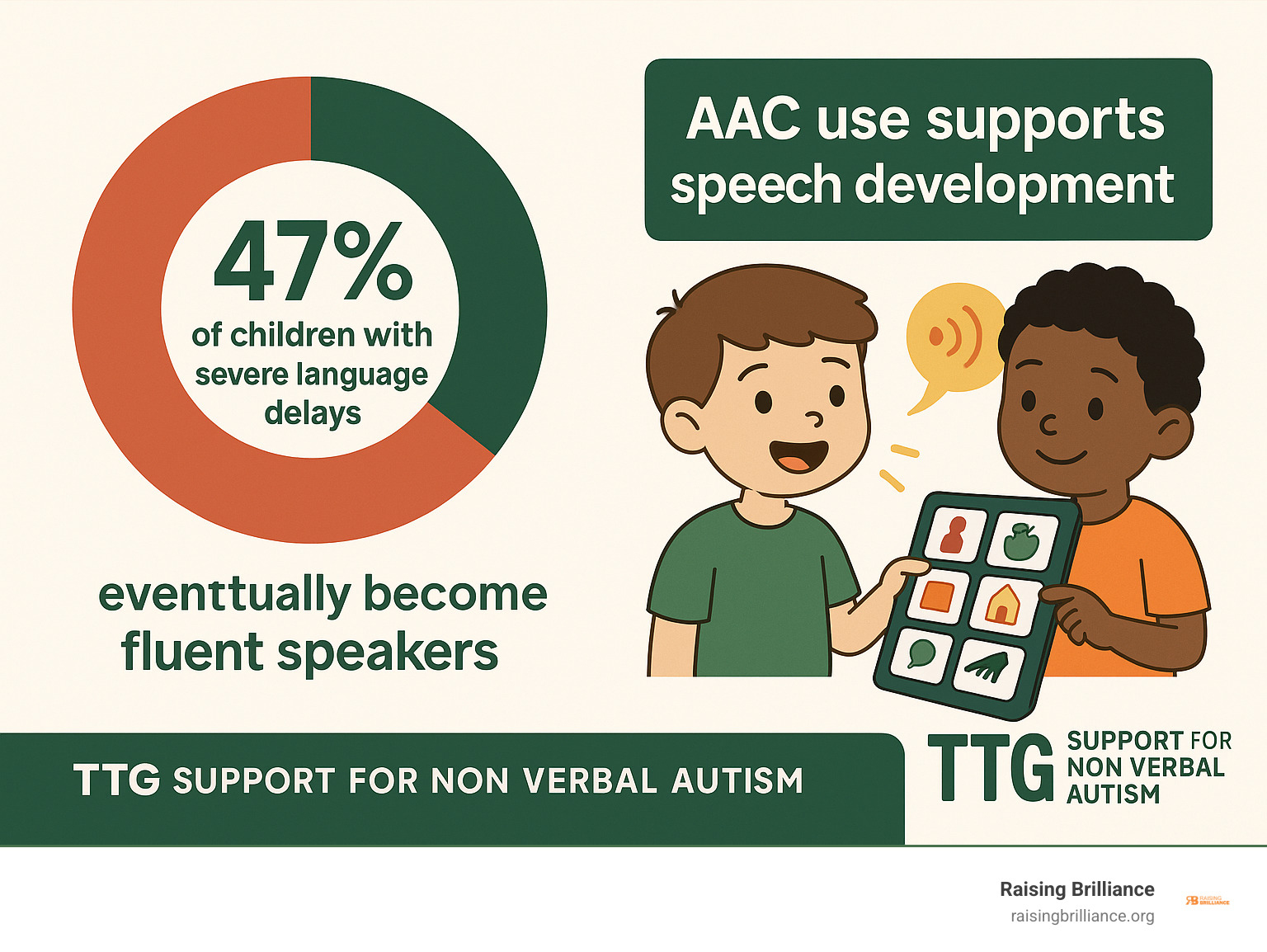- Raising Brilliance
- Posts
- Unlocking Communication for Non-Verbal Autism with These Proven Tips
Unlocking Communication for Non-Verbal Autism with These Proven Tips
Discover proven tips and tools for support for non verbal autism to empower communication and foster independence at every age.
Why Understanding Support for Non-Verbal Autism Changes Everything

Support for non verbal autism starts with understanding that communication goes far beyond spoken words. Research shows that roughly 25-40% of autistic individuals are minimally verbal or don't use speech as their primary way to communicate.
Key support strategies include:
Visual supports - Picture cards, communication boards, and visual schedules
Augmentative and Alternative Communication (AAC) - From simple picture exchange systems to high-tech speech devices
Environmental modifications - Creating predictable, sensory-friendly spaces
Family coaching - Teaching caregivers to model communication and provide consistent support
Professional collaboration - Working with speech therapists, occupational therapists, and educators
The good news? Many children who start as non-verbal can develop communication skills over time. Research indicates that even after age 4, many children with autism eventually develop language when given the right support and tools.
Your child has something to say - they just need the right pathway to express it. Whether through gestures, pictures, sign language, or technology, there are proven ways to open up their communication potential.

What Is Nonverbal Autism? Definitions, Causes & Prevalence
When we talk about support for non verbal autism, we first need to understand what this term actually means. About 1 in 100 children are diagnosed with autism, and within this group, roughly 25-40% don't develop typical spoken language.
But here's what's really important to understand - not speaking doesn't mean not communicating. Many nonspeaking autistic individuals are highly intelligent, become published authors, and live fulfilling independent lives as adults.
The reasons behind these communication differences are complex. Research shows us that genetics and brain development play major roles, with specific areas of the brain - particularly those controlling language and motor planning - developing differently. Apraxia of speech is another common factor, where the brain has trouble coordinating the muscle movements needed to form words clearly.
Key Terms Explained
The words we use matter enormously, especially to autistic people themselves.
Nonverbal has been the traditional term, but it can be misleading since up to 93% of human communication isn't verbal anyway!
Nonspeaking is often preferred because it's more specific - it simply means not using spoken words while acknowledging that communication is happening in other ways.
Minimally verbal describes people who use some words but have limited functional speech, typically fewer than 30 words that they use consistently.
Why Some Autistic People Don't Speak
Understanding the "why" behind speech differences helps us provide better support for non verbal autism. There are several reasons why some autistic individuals don't develop spoken language:
Motor planning challenges are huge. The brain struggles to coordinate all the precise movements needed for speech.
Oral-motor tone issues make speech physically difficult. When the muscles in the face, mouth, and throat have low tone, forming clear sounds becomes exhausting work.
Sensory overload can temporarily or permanently affect speech. When someone is overwhelmed by noise, lights, or other sensory input, speaking might become impossible.
Selective mutism related to anxiety means some individuals can speak comfortably at home but not at school or in public.
Scientific research on prevalence continues to deepen our understanding of these communication differences, giving us better ways to support every individual's unique communication journey.
Core Communication Foundations & AAC Toolkit
When it comes to support for non verbal autism, the magic happens when we realize communication is like a symphony - it works best when multiple instruments play together. This approach is called multimodal communication.
Think of "Total Communication" as creating a home where every form of expression is welcomed. Your child might use sign language to ask for their favorite snack, hand you a picture card when they need help, or point to a visual schedule to show what they want to do next.
Sign language and Makaton give children a visual way to express themselves that often feels more natural than struggling with speech sounds.
The Picture Exchange Communication System (PECS) offers a structured pathway that starts simple - your child learns to hand you a picture of something they want. From there, it grows into more complex communication.
Visual supports like communication boards and picture schedules act as constant communication partners. They're always available and give children the processing time they need to express themselves.
Modern AAC devices have transformed what's possible. Today's speech-generating tablets and dedicated devices use AI technology to create personalized synthetic voices that sound uniquely like your child.
Communication passports serve as your child's personal introduction to the world, helping teachers, therapists, and community members understand exactly how your child communicates best.
Differentiating Tools: Low-Tech vs High-Tech

Choosing AAC tools doesn't have to feel overwhelming. The best approach often starts simple and grows with your child's skills.
No-tech options include gestures, facial expressions, body language, and sign language. These are always available and never need charging!
Low-tech solutions bring more structure without complexity. Picture cards, PECS books, and choice boards give children concrete ways to communicate specific needs. These tools are affordable, portable, and incredibly effective.
High-tech AAC opens up unlimited possibilities. Tablet-based apps can speak thousands of words, while dedicated devices offer durability and specialized features. Eye-gaze systems help children with motor challenges.
The secret? Most successful communicators mix and match. Start where your child feels comfortable, then gradually introduce new tools as they're ready.
Teaching AAC for Support for Non Verbal Autism
Teaching AAC effectively requires patience, consistency, and a team approach.
Aided language stimulation is like giving your child a communication bath. Throughout the day, you model using their AAC system naturally. If you're making lunch and your child uses picture cards, you might point to pictures while talking: "I'm making a sandwich. Do you want peanut butter?"
The prompting hierarchy helps you provide just enough support without taking over. Start with expectant waiting, then try indirect cues, direct prompts, gestures, and finally physical guidance only if needed.
Collaboration between speech-language pathologists, occupational therapists, and families makes the biggest difference. When everyone works together with the same goals and methods, progress accelerates.
Scientific research on AAC consistently shows these tools improve rather than hinder communication development. For families looking for additional therapeutic approaches, Verbal Behavior Therapy can complement AAC strategies beautifully.
Proven Strategies & Daily Support for Non-Verbal Autism
The most effective support for non verbal autism doesn't happen in a therapy room - it happens in the kitchen while making breakfast, during playtime on the living room floor, and in those quiet moments before bedtime.
Play-based learning creates the perfect stage for communication growth. Get down on your child's level during play - literally. If they're fascinated by spinning toy cars, join them on the floor and share that joy.
Imitation is one of your most powerful tools. When your child makes a sound - any sound - mirror it right back. You're showing them that their communication attempts matter.
The "one-up" rule becomes your friend. If your child points to a cookie, you might say "want cookie" while pointing too. You're always building just one step higher than where they are right now.
Strategic pausing takes practice. After you ask "Do you want more?" - pause. Count to ten in your head. Many autistic children need extra processing time, and your patience shows them their response is worth waiting for.
Social stories can help prepare for new situations or explain daily routines. These simple, personalized stories use pictures and words to describe what will happen and what's expected.
Creating sensory-friendly routines supports communication by reducing overwhelm. When a child isn't struggling with bright lights or loud noises, they have more energy available for communicating.

Home Routines & Family Coaching for Support for Non Verbal Autism
Your home is the most important classroom your child will ever have. Routine visuals transform daily activities into communication opportunities. That first/then board showing "eat breakfast, then play" teaches cause and effect while giving your child a way to understand their world.
Choice boards turn everyday decisions into communication practice. Instead of automatically putting on their blue shirt, show them two options. Even pointing to make a choice is meaningful communication.
Modeling gestures throughout your day creates a rich visual language environment. Wave goodbye with exaggerated enthusiasm. Point to objects you're talking about. Your child is absorbing this visual vocabulary even when they're not responding yet.
Parent-implemented therapy works because you know your child best. You understand their interests, their quirks, and what makes them laugh. Research consistently shows that parents can successfully support communication development at home when given the right guidance.
If you're just beginning this journey, our guide on How to Prepare for an Autism Diagnosis can help you build the support network your family needs.
Classroom & Therapy Settings
School environments need to become Total Communication spaces where every adult understands and supports your child's communication method.
Processing time becomes even more critical in busy classroom settings. Teachers need to understand that silence doesn't mean your child doesn't know the answer - it might mean they need an extra 30 seconds to organize their thoughts.
Peer modeling in inclusive settings provides natural communication opportunities. When neurotypical classmates use words, gestures, and expressions throughout their play, they're creating a living language laboratory.
Inclusive play opportunities help nonverbal children practice communication in meaningful contexts. Playing restaurant with AAC menus, or building blocks while practicing "more" and "help" makes communication functional and fun.
For comprehensive information about different therapeutic approaches, explore our resource on Autism Therapy Options.
Fostering Autonomy & Self-Advocacy
Communication is fundamentally about having a voice in your own life. Article 19 of the UN Declaration recognizes communication as a basic human right.
Yes/no systems form the foundation of self-advocacy. Whether through head nods, pointing to symbols, or pressing buttons on an AAC device, every person deserves a clear way to express consent and preferences.
Energy meters often work better than emotion charts for many autistic individuals. A simple visual scale showing battery levels from "full charge" to "needs rest" can help someone communicate their internal state.
Communication passports serve as bridges between your child and the world. These personalized guides explain how your child communicates, what their behaviors mean, and how others can best interact with them.
Respecting refusals builds trust and reinforces that communication has real power. When your child says "no" through any method - honor it whenever safely possible.
Building an Inclusive Environment & Busting Myths
One of the biggest barriers to effective support for non verbal autism is misconceptions about what nonverbal means. Let's address these head-on.
Myth: Nonverbal equals intellectually disabled Reality: Communication ability doesn't reflect intelligence. Many nonverbal autistic individuals have average or above-average intelligence and go on to write books, hold jobs, and live independently.
Myth: If someone doesn't speak, they don't understand Reality: Receptive language (understanding) often develops separately from expressive language (speaking). Many nonverbal individuals understand everything said around them.
Myth: AAC devices will make children lazy about speaking Reality: Research consistently shows that AAC supports and can actually promote speech development. It provides a bridge to communication while speech skills develop.
Myth: Nonverbal children will never communicate meaningfully Reality: With appropriate support, nonverbal individuals can communicate complex thoughts, emotions, and needs through various methods.

Communities are beginning to recognize their role in supporting communication access. Some councils have installed communication boards in public spaces like playgrounds, making these environments more inclusive for nonverbal individuals.
Adapting Community Communication for Support for Non Verbal Autism
Creating truly inclusive communities requires systematic changes:
Plain Language: Use clear, direct language in public communications. Avoid idioms, metaphors, and complex sentence structures.
Visual Supports: Include pictures and symbols alongside text in public spaces. This benefits not only autistic individuals but also people with various communication needs.
Multiple Communication Options: Offer written alternatives to verbal-only interactions. Train staff to be patient and flexible with communication methods.
Sensory Accommodations: Reduce overwhelming sensory input in public spaces. This might include quiet hours, dimmed lighting, or designated calm spaces.
Common Misconceptions Debunked
Let's tackle some persistent myths with facts:
"AAC stops children from learning to speak" This is completely false. Studies show that AAC often facilitates speech development by reducing communication frustration and providing language models.
"All nonverbal kids stay nonverbal forever" Research indicates that 47% of children with severe language delays at age four eventually become fluent speakers with appropriate intervention.
"Nonverbal people can't learn academic skills" Many nonverbal students excel academically when given appropriate communication supports. Intelligence and speech ability are separate skills.

Lifespan & Future Outlook: From Early Childhood to Adulthood
Support for non verbal autism looks different at every stage of life. What helps a three-year-old communicate their needs will evolve dramatically by the time they're a teenager planning for college or work.
Here's something that might surprise you: language development doesn't follow a predictable timeline. Some children surprise everyone by speaking their first words at age seven. Others become fluent communicators using AAC devices and never need spoken words. Both journeys are completely valid.
The research gives us real hope. Studies show that 47% of children with severe language delays at age four eventually become fluent speakers when they receive appropriate support. Even more encouraging? Language development can continue well into adolescence and even adulthood.
In early childhood (ages 2-6), the focus is on building communication foundations through AAC tools, play-based interaction, and building language understanding.
During school years (ages 6-12), communication becomes more complex. Children learn to use AAC for academic tasks, social interactions, and expressing increasingly sophisticated thoughts.
Adolescence (ages 12-18) brings new challenges. Teenagers need to communicate about relationships, independence, and future plans. Their AAC systems often become more sophisticated.
In adulthood, communication supports help with employment, relationships, and community participation. The goal shifts from developing communication skills to using them for a fulfilling, independent life.
Tracking Progress & Adjusting Support
Think of communication development like tending a garden - it requires patience, consistent care, and adjustments based on what's working.
Goal setting should focus on what matters most for your child's daily life. Instead of abstract language targets, consider goals like "requests help when frustrated" or "shares excitement about favorite activities."
Data collection doesn't have to be complicated. Notice when your child communicates successfully and what seemed to help. Was it a quiet environment? A favorite activity? These patterns guide future support strategies.
Professional partnerships remain crucial throughout development. Speech-language pathologists can adjust therapy approaches as your child grows and their needs change.
For families wondering about therapy intensity and scheduling, our guide How Many Hours of Speech Therapy for Autism? provides evidence-based recommendations.
Adult Communication & Quality of Life
Communication support doesn't end at graduation. Adults with autism often continue developing new communication skills throughout their lives.
Employment opportunities are expanding for nonverbal adults. Many employers are finding that autistic employees bring unique strengths like attention to detail, reliability, and innovative problem-solving.
Community inclusion requires both individual skills and community awareness. Adults need to communicate with healthcare providers, participate in social activities, and access community services.
Technology continues evolving rapidly. Adults benefit from periodic technology assessments to access new features that could improve their communication and independence.
The future outlook for nonverbal autism has never been brighter. Technology advances, increased awareness, and better support strategies mean that today's children will have opportunities previous generations couldn't imagine.
Frequently Asked Questions about Support for Non Verbal Autism
Can nonverbal autistic children learn to speak?
This is probably the question that keeps most parents awake at night. The answer brings both hope and perspective: yes, many nonverbal autistic children do develop speech, often much later than we might expect.
Research offers encouraging news. A major study found that 47% of children with severe language delays at age four eventually became fluent speakers with appropriate intervention. That's nearly half of children who seemed unlikely to speak at age four going on to develop functional language.
The timeline looks different for autistic children. While typical children usually start talking by age two, some autistic children don't begin speaking until they're eight, ten, or even into their teens. Language development can continue well into adolescence and adulthood when the right support is in place.
The factors that make the biggest difference include early intervention with speech therapy, consistent family involvement, and addressing underlying challenges like apraxia or oral-motor difficulties.
Will AAC stop my child from talking?
I hear this worry from families all the time, and I completely understand it. But research tells us exactly the opposite story.
AAC actually supports and encourages speech development rather than hindering it. When children are frustrated because they can't communicate, that frustration becomes a barrier to learning. AAC removes that barrier and lets them experience the joy and power of communication.
Here's what really happens when children use AAC: they start understanding that communication gets them what they need and want. This motivation often drives them to try speaking too. Many children begin imitating the words their device says, using it as a speech model.
AAC also teaches crucial language concepts like vocabulary, sentence structure, and conversation skills that transfer directly to verbal communication. The device becomes a stepping stone, not a roadblock.
How can I find low-cost AAC devices?
Effective communication support doesn't have to break the bank, and there are more options available than most families realize.
Start with what you might already have. Many families own tablets or smartphones that can run AAC apps. Apps like Proloquo2Go often offer free trials, and some simpler communication apps cost under $50.
Insurance coverage has improved dramatically in recent years. Many insurance plans now cover AAC devices as durable medical equipment, especially when prescribed by a speech-language pathologist.
School districts can be valuable partners too. They're required to provide communication supports for students who need them, and many will conduct AAC evaluations and provide device loans.
For families who need additional funding support, several grant programs specifically help with communication devices. The National Autism Association's Give A Voice program and The Orange Effect Foundation both provide grants for AAC equipment.
Don't overlook low-tech solutions either. Some of the most effective communication happens with simple picture boards, choice cards, or sign language - all of which cost very little to implement.
Conclusion
Every child has something important to say - they just need the right pathway to share their thoughts, needs, and feelings with the world. Support for non verbal autism isn't about fixing what's broken; it's about building bridges to help remarkable minds connect with the people around them.
Throughout this guide, we've explored how communication happens in so many ways beyond spoken words. From simple picture cards to high-tech speech devices, from sign language to environmental supports, there are countless proven methods that work. The magic happens when we meet children exactly where they are and gently expand their communication toolkit from there.
Your child's communication journey is uniquely theirs. Some children will develop speech over time, while others will become eloquent through alternative methods. Both paths are valuable and worthy of celebration.
The research gives us real hope. Nearly half of children who are nonverbal at age four eventually develop fluent speech with the right support. But even more encouraging is knowing that every child can learn to communicate meaningfully when given appropriate tools and understanding adults who believe in their potential.
Progress often happens in small, everyday moments. A child pointing to request their favorite snack, using a picture to share excitement about a playground visit, or pressing a button on their device to say "more" - these are all profound communication victories worth celebrating.
Starting can feel overwhelming, but you don't have to figure everything out at once. Begin with one simple strategy, like offering choices with pictures or modeling gestures during daily routines. Collaborate with speech therapists and other professionals, but trust your parental instincts too.
At Raising Brilliance, we believe every family deserves access to quality information and support, regardless of their financial situation. That's why we provide free resources to help you steer this journey with confidence and hope.
Communication development can continue throughout your child's entire life. What might seem impossible today could become reality with patience, creativity, and consistent support. Your child has so much to offer the world - they just need the right tools to share their brilliance.
For practical strategies to support your child's growing independence alongside their communication development, explore our comprehensive guide on Tools for Fostering Independence in Autistic Children.
Your child's voice - however it emerges - deserves to be heard, valued, and celebrated. Trust the journey, celebrate the small victories, and remember that you're not walking this path alone.